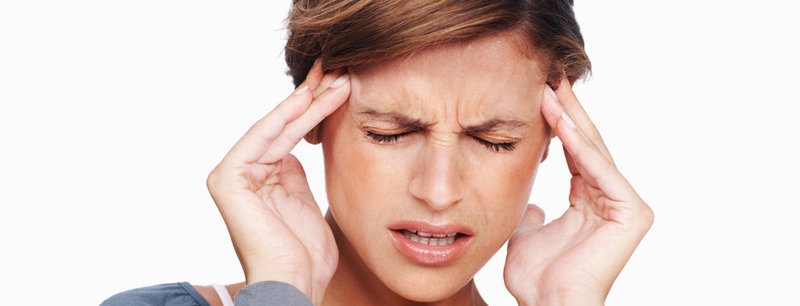Almost all people have experienced sharp pain in temple or area around and some may have suffered more headaches than others. Minor headache can be a nuisance, but it is often relieved by taking over the counter pain reliever, foods or just a short rest. If you have headaches that are severe or unusual, you may be worrying about blood clot, stroke or tumor. It is important that you know when a headache requires urgent medical care. You should also learn to control some types of headaches even they are not threat to your health.

Common Causes of Sharp Pain in Temple
Migraines
Migraines are characterized as one sided headache. Migraine is an episode of sharp in temple and it is often accompanied with nausea and vomiting. Causes of migraine may include hormone fluctuations, alcohol intake, food intolerance and anxiety. The migraine pain normally builds up over an hour before it reaches the maximum. Migraine does not occur suddenly, there is some sort of warning or prodrome before the sharp pain in temple or head is felt.
Tension Headaches
Tension headaches are another cause of sharp pain in temple or head area, which can bring discomfort that is hard to bear. The pain is felt due to the muscle tightness that may be present in the area of the headache. Tension headaches occur when scalp muscles and neck are tense due to certain activities like too much computer work. Symptoms of tension headaches include dull pain and difficulty sleeping.
Cluster Headache
Cluster headache refers to head pain which tends to recur over several weeks and the pain is always observed on one side of the head. The pain associated with cluster headache can be excruciating in one side of the head which can be felt in the eyes and also may lead to runny nose. This condition is experienced on every day basis for 8 to 10 weeks and it is followed by a remission which can last for a year.
Other Causes
Other disorders and conditions can also cause localized pain in temple, which include sinus problems, sinus inflammation, sinus infections and stroke. Likewise, grinding the teeth can lead to localize pain in the right temple, too. It is important that you go to see a doctor to get your condition diagnosed in time.
Less Common Causes of Sharp Pain in Temple
Trigeminal Neuralgia
Also known as tic douloureux, trigeminal neuralgia is a chronic pain condition which feature shooting and intermittent pain on the right side of the head. The disorder occurs when the blood vessels put pressure on the nerve near the brain stem and over time the myelin sheath wears away, thus causing the development of symptoms. Symptoms of trigeminal neuralgia include severe stabbing pain which may last for several seconds. The symptoms can occur one after another and may even last all day long. In some cases, the condition is felt for several days up to years.
Temporal Arthritis
Temporal arthritis occurs when the blood vessels responsible for supplying blood in the head area suffer damage and inflammation. Due to the inflammation, the medium and large arteries that are located in the neck and temporal area are affected. The real cause of temporal arthritis is not really clear though it is believed that the immune response is the culprit. Symptoms of temporal arthritis are excessive sweating, muscle ache, persistent fever, vision problems, loss of appetite and throbbing headache on one side of the head.
Temporomandibular Joint Disorder
Temporomandibular is the hinge like connection that is located in front area of the ear between the skull and the lower jaw. Any abnormalities that are functional and structural in the temporomandibular joint are called temporomandibular joint disorder. Individuals suffering from TMJ may experience several symptoms like neck pain, stiffness in the jaw muscles, pain while chewing, difficulty in opening the mouth, and headaches that may even radiate to the temporal part of the head.
Temporal Lobe Tumors
Common symptom of brain tumor is headaches and it is often localized in the right temple. The pain felt in temple is usually more severe in the morning and the condition may improve during the day. Pain characterized as deep ache may worsen over time and relief may come after vomiting.
Numular Headache
Numular headache is a condition which normally affects people who are 50 years old and above. The condition occurs when the artery becomes inflamed. It can cause temple headache and the artery on the temple is tender to touch. The scalp also appears tender. Individuals suffering from nummular headache generally feel unwell and may also lose their appetite. If not treated early, the blood supply to the eye may be affected, thus resulting to loss of vision.
Hemicrania Continua
Craniotomy is a kind of surgery which needs the skull to be opened. In the procedure, part of temporal bone is lifted and screwed again after the procedure is done. So, localized headache may occur on the site of surgery. In this case, the sharp pain in temple may be felt in three months.
When Should I Be Concerned?
You can probably deal with several kinds of headaches by yourself with home remedies and your doctor may provide some medications to manage the sharp pain in temple or head, especially severe ones. However, there are some headaches that require immediate medical care. Some of warning signs to look out include:
Headaches first experienced after 50 years old.
Pain that gets worse while moving or coughing.
Change in mental function or personality.
Headaches that are felt along with stiff neck, visual disturbances, slurred speech, seizure, numbness and weakness.
Headaches with painful red eye or have tenderness near the temples.
Sharp pain in temple or head in patients with poor immune system or cancer.

View All Comments /Add Comment